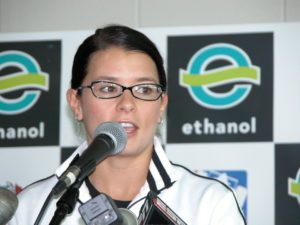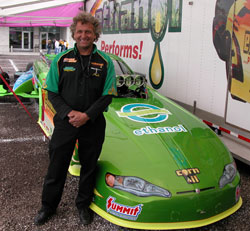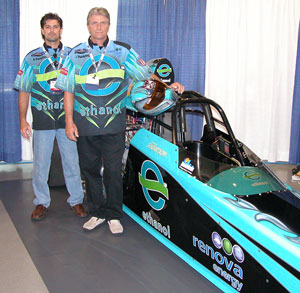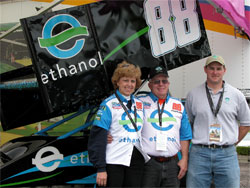Triumph and tragedy strike Team Ethanol
In January 2006, it was announced that Paul Dana and Team Ethanol would be leaving Hemelgarn Racing and joining the Rahal Letterman group, owned by 1986 Indy 500 winner Bobby Rahal and television talk show host David Letterman. “This is a huge step up for us from a competitive standpoint because Rahal Letterman has such an excellent track record,” Dana said. “My teammates will be Buddy Rice, who won the Indy 500 in 2004, and, of course, Danica Patrick, who was Rookie of the Year last year.”Dana could barely contain his excitement with the change and the increase in visibility that the new team will bring for ethanol. “I’m the luckiest guy in North America to be able to drive this car with this team,” he said in an interview at the time. “I’m blown away with the opportunity to be able to work with a legend like Bobby and his whole team.”
Dana said he was fully recovered from the back injury he that put him out of action in 2005 after just three races. “I’m stronger than I’ve ever been in my life, my head’s clear, and I’m ready to go,” he said. “I’m looking forward to getting back in the car after my injury and hopefully figuring out a way to race towards the front.”
March 26 was the first race for the 2006 IndyCar season to run on 10 percent ethanol in the Toyota Indy 300 at Homestead-Miami Speedway. Dana was thrilled to qualify in the top ten for the race. “It’s great for my confidence since I’m going for Rookie of the Year this year,” Dana said in a telephone interview the night before the race. “But payday is tomorrow and qualifying really doesn’t matter – we’re not done yet.”
Dana could hardly have been more optimistic about the future. “It’s a whole new world, bright new day and I can’t wait for the season to start tomorrow,” he said as he concluded the interview.
Sadly, the bright new day for Paul Dana ended almost as soon as it began. In a practice session early Sunday morning before the race, Dana collided with a disabled car on the track and died from his injuries. The race went on as scheduled, but Dana’s teammates Buddy Rice and Danica Patrick did not compete out of respect. “It is a black day for us, and on behalf of Rahal Letterman Racing, our sponsors and associates, our prayers and sympathy go out to the entire Dana family,” said team co-owner Bobby Rahal.
“Paul was a very special guy,” said ICM’s David Vander Griend. “He demonstrated his belief in what ethanol can do for all of America through his racing. He helped us with so many things in bringing ethanol to the IndyCar Series. He will be missed tremendously.”
David Letterman paid tribute to Paul during his Tonight Show opening monologue on March 27. “It’s not hard to imagine the despair and sorrow that Paul Dana’s wife, Tonya, and the rest of his family are feeling now, and I want them to know that they have the thoughts and the prayers of myself, the entire Rahal-Letterman team, and the entire racing community and, hopefully, that will give them the slightest amount of comfort.”Tonya had been back home in Indianapolis that Sunday as her husband prepared for the race. She was even more excited than he was and could not wait to talk to him after the race to tell him the big news – she had just found out she was pregnant with their first child.
Paul Conner Dana was born before the end of 2006, and at the 2007 Indy 500 Tonya said while the loss was still fresh, having Paul’s son kept her going. “He’s an absolute joy and blessing in my life and I owe it to Paul to just do the best I can and make him proud,” she said.
Keeping the Momentum Going
While Paul’s loss was heartbreaking for everyone involved with Team Ethanol there was no time for mourning. A new driver had to be named immediately because the IndyCar Series moves fast.
 On April 4, Jeff Simmons, “the winningest driver in IRL Indy Pro Series (IPS) history with seven victories” was chosen to pilot the No. 17 Team Ethanol Honda/Panoz/Firestone car. The team had already missed the second race of the series in St. Petersburg, but Simmons was able to compete in the Indy Japan 300 April 22. He contested the remainder of the 2006 IRL IndyCar Series season and finished 16th in series points despite missing the first two races.
On April 4, Jeff Simmons, “the winningest driver in IRL Indy Pro Series (IPS) history with seven victories” was chosen to pilot the No. 17 Team Ethanol Honda/Panoz/Firestone car. The team had already missed the second race of the series in St. Petersburg, but Simmons was able to compete in the Indy Japan 300 April 22. He contested the remainder of the 2006 IRL IndyCar Series season and finished 16th in series points despite missing the first two races.
“I am honored to have the opportunity to promote the message and need for the clean-burning, renewable fuel ethanol and to become a member of Rahal Letterman Racing,” said the 29-year-old Simmons. “The fact that I have this opportunity as a result of Paul’s passing is not lost on me, and I want to express my deepest sympathies to his family and friends.”
Simmons was a native of Connecticut, so he had a lot to learn about ethanol in order to serve as a spokesperson for the industry, as well as a driver. His first test in that role was the 2006 Indy 500, which included promotional events in the weeks leading up to the race.
 The ethanol industry was experiencing a wave of momentum pioneers in the industry had only dreamed of, boosted by President Bush’s State of the Union address which offered ethanol as a pathway out of our addiction to oil. “We must also change how we power our automobiles,” Bush said. “We will also fund additional research in cutting edge methods of producing ethanol, not just from corn, but from wood chips and stalks or switch grass. Our goal is to make this new kind of ethanol practical and competitive within six years.”
The ethanol industry was experiencing a wave of momentum pioneers in the industry had only dreamed of, boosted by President Bush’s State of the Union address which offered ethanol as a pathway out of our addiction to oil. “We must also change how we power our automobiles,” Bush said. “We will also fund additional research in cutting edge methods of producing ethanol, not just from corn, but from wood chips and stalks or switch grass. Our goal is to make this new kind of ethanol practical and competitive within six years.”
The president’s Advanced Energy Initiative included a 22 percent increase in Department of Energy clean energy research funding and U.S. Secretary of Energy Samuel Bodman was in the driver’s seat.
The Bush Administration Department of Energy joined the industry in a promotional “Ethanol Day” at the Indianapolis Speedway on May 11, featuring Secretary Bodman suiting up in an ethanol track suit and taking a ride in a two-seater for the media. In a trackside interview, Bodman was enthusiastic about the role of ethanol in American energy independence. “This will be the solution to the President’s observation that we have a nation that’s really become addicted to oil,” said Bodman. “To have something homegrown that we can take advantage of and take the pressure off these markets, it’s going to be a great thing for America.”
 Team Ethanol was in the spotlight for Ethanol Day, but the racing world was in love with Danica Patrick, so having her on board as part of Rahal Letterman Racing a big bonus. “I’m proud to be close to the source with them being involved with Rahal Letterman,” Patrick told the media that day. “I think that anything that acts in the movement of making the world a better place and cleaner then I’m all for it.”
Team Ethanol was in the spotlight for Ethanol Day, but the racing world was in love with Danica Patrick, so having her on board as part of Rahal Letterman Racing a big bonus. “I’m proud to be close to the source with them being involved with Rahal Letterman,” Patrick told the media that day. “I think that anything that acts in the movement of making the world a better place and cleaner then I’m all for it.”
Having 2005 Rookie of the Year Danica Patrick and 2004 Indy 500 winner Buddy Rice as teammates for Rahal Letterman Racing was definitely a plus for Jeff Simmons and Team Ethanol. “The primary ethanol signage and promotion will be my responsibility but having Danica and Buddy, who are popular and very competitive drivers just adds to it all,” Simmons said.
Simmons helped to educate Sec. Bodman about Indy racing and the performance value of ethanol. “It shows how interested the government is becoming in this fuel.”
Drag Racing and Hot Rods on Ethanol
Getting the Indy Racing League to use ethanol was by far the highest profile racing accomplishment for the fuel, but it was far from the only racing game in town, and many had been using homegrown fuel for years. The Ethanol Promotion and Information Council began supporting some of the smaller leagues as well in 2006.Wyoming Ethanol Racing was founded by 17-year racing veteran Dan Schwartzkopf, who was also general manager of the plant by the same name owned by Renova Energy. The five-car drag team already raced with a high-performance fuel known as E-85. “EPIC is a natural fit as our title team sponsor since we use E-85 to give us a performance advantage,” said Schwartzkopf.
The Wyoming Ethanol plant was started as a 1.5 million gallon dry mill facility in 1993, but by 2006 had grown to five million gallons and expanded to double production the following year. Schwartzkopf started Wyoming Ethanol Racing to promote the product and Renova Energy went on to become the supplier of ethanol for the IndyCar Series in 2007.
 Arguably the most famous racing farmer in history, Mark Thomas made his mark in the International Hot Rod Association (IHRA) Funny Car competition.
Arguably the most famous racing farmer in history, Mark Thomas made his mark in the International Hot Rod Association (IHRA) Funny Car competition.
Thomas was inducted into the IHRA Hall of Fame in 2021 as a seven-time IHRA world champion in Alcohol Funny Car and one of the five winningest professional drivers in IHRA history, joining a list that includes names such as Clay Millican, Rickie Smith, Scotty Cannon, and Don Garlits.
Thomas farmed 2300 acres and milked 500 cows and had been racing with the support of the Ohio Corn Growers for years. EPIC helped raise his profile a little more in 2006 and he won two of his seven championships under the EPIC banner before he retired to be a full-time farmer in 2008. He was an enthusiastic supporter of a fuel that he grew himself. “We’ve supported ethanol for years and actually got our sanctioning body (IHRL) to switch over and let us run 100 percent ethanol in 1990,” said Thomas.
“I’m either in a tractor or a combine or I’m at a racetrack somewhere,” he said. “It’s great that farming and racing have that tie in ethanol.”
The National Corn Growers Association and RFA brought Mark and his ethanol funny car up the Hill to Washington D.C. in May of that year, as negotiations to increase the Renewable Fuel Standard set in the 2005 Energy Act were underway already before the ink was even dry on the EPA regulations for RFS1. Sen. Jim Talent (R-MO) was just one of many lawmakers who posed with Corn Cob Bob and the funny car on the Hill. Bob Dinneen remembers the day well.
 Mark Thomas was in Washington to participate in the IHRA President’s Cup race held annually in September about 40 miles southeast of D.C. at the Budd’s Creek Raceway. Mark was an excellent and articulate spokesperson who could talk racing, fuel performance, energy policy, and farming with ease and credibility. There were still far too many Capitol Hill staffers who saw ethanol as just some sort of novelty, not as a fuel source that could help power the nation’s economy. So, Jon (Doggett with NCGA) and I decided we would offer a bipartisan group of Senate and House staff the opportunity to watch a race and learn about ethanol and its high-performance capabilities from Mark. Jon assigned a new NCGA intern to coordinate the effort, securing a bus, tickets to the event, food and drink, and invitations to go to the Hill. That intern, Cory Gardner from Colorado, would later be elected to the United States Senate. But in 2006, he was a lowly intern with extraordinary skill and ambition who did his job quite well.
Mark Thomas was in Washington to participate in the IHRA President’s Cup race held annually in September about 40 miles southeast of D.C. at the Budd’s Creek Raceway. Mark was an excellent and articulate spokesperson who could talk racing, fuel performance, energy policy, and farming with ease and credibility. There were still far too many Capitol Hill staffers who saw ethanol as just some sort of novelty, not as a fuel source that could help power the nation’s economy. So, Jon (Doggett with NCGA) and I decided we would offer a bipartisan group of Senate and House staff the opportunity to watch a race and learn about ethanol and its high-performance capabilities from Mark. Jon assigned a new NCGA intern to coordinate the effort, securing a bus, tickets to the event, food and drink, and invitations to go to the Hill. That intern, Cory Gardner from Colorado, would later be elected to the United States Senate. But in 2006, he was a lowly intern with extraordinary skill and ambition who did his job quite well.
Approximately 50 Capitol Hill staffers accepted the invitation and joined the RFA/NCGA trek to southern Maryland for the races. Cory had rented a bus, which was stocked with beer for the largely 20-something group, and Jon joined the group on the bus to give a few opening remarks, answer questions, and discuss a bit of policy on the 45-minute bus ride to Budd’s Creek. I lived just a few minutes from the track, so I met the group at the track. Cory had also assigned me the important responsibility of picking up the barbequed spareribs, beans, corn and other goodies from a local roadside BBQ pit known locally for the best ribs anywhere!
Quite unfortunately, however, I somehow forgot to grab the beans and I had to call my long-suffering wife to pack up the toddler, grab the beans, and meet me at the track. She did so without complaint, of course, even though she didn’t have a parking permit that would get her close to the pit area and she had to schlep with the toddler and the hot and heavy beans more than a mile to deliver them to the tent. I paid for that misstep for weeks!
 By the time Maureen arrived with the beans, the bus filled with Capitol Hill staffers had arrived and the tent near the pit area was filling up with very hungry, thirsty kids soaking up the local atmosphere. Mark greeted the group and talked a little about what they would see throughout the day, the rules of drag racing, top speeds, risks, and, of course, the fuel. It was a phenomenal event. But Mark had to get to his car and prepare for his race, so off he went, and Jon and I escorted the staff to the track.
By the time Maureen arrived with the beans, the bus filled with Capitol Hill staffers had arrived and the tent near the pit area was filling up with very hungry, thirsty kids soaking up the local atmosphere. Mark greeted the group and talked a little about what they would see throughout the day, the rules of drag racing, top speeds, risks, and, of course, the fuel. It was a phenomenal event. But Mark had to get to his car and prepare for his race, so off he went, and Jon and I escorted the staff to the track.
There are no assigned seats at Budd’s Creek. It’s only a quarter mile, but some staff wanted to watch the start and others wanted to watch the finish, so the group quickly became spread across the entire track area as race after race ensued. Patrons of drag racing enjoy their adult beverages. The beer flows freely. And a group of Capitol Hill staff were somewhat conspicuous by their dress and demeanor, which made for some interesting interactions between our group and the locals!
Mark raced well that day, qualifying for the finals the following day. His alcohol funny car hit a top speed of 220 miles an hour and crossed the quarter mile mark in less than 6 seconds and burned two gallons of ethanol! Okay, so drag racing isn’t fuel efficient, but it is exciting, and the trip seemed to be a wild success.
Another Team Ethanol Tragedy
Sadly, Paul Dana was not the only EPIC-sponsored racer to lose his life in 2006.Steve King was a fourth-generation farmer who lived and worked on the family’s row crop and feedlot operation outside of Jetmore, Kansas. Steve and his parents worked the farm together and raced together.
King was a 17-time National Championship Racing Association (NCRA) 360-cubic-inch sprint car feature winner who won NCRA 360 Division titles in 2002 and 2003. He began using a ten percent ethanol/90 percent methanol racing blend fuel in 2001. “It’s just like getting better gas mileage in your car, we get the same amount of horsepower with less fuel, so we can start with a lighter fuel load at the beginning of the race,” he said during an interview at the Ethanol Day promotion.
Three months after King and his parents took part in Ethanol Day at the Indianapolis Speedway, and less than six months after Paul Dana was killed, a part broke on King’s No. 88 ethanol car during a race in Knoxville, Iowa sending him careening into a wall. He was pronounced dead as a result of his injuries August 10 at the age of 33.
Steve was in the second year of his sponsorship with Ethanol/ICM at the time of his death. Steve won his heat, setting a new 10-lap record and was running 16th in the qualifying feature at the time of the accident, which occurred on the white flag. He was posthumously awarded the ninth-place trophy. At the time of his death, Steve was the second most-winning driver in NCRA history.
To say it spooked EPIC and the Team Ethanol members to have two drivers die in the first year of the high-octane ethanol racing promotion was an understatement. But the industry was in it to win 100 percent and 2007 was another year.



